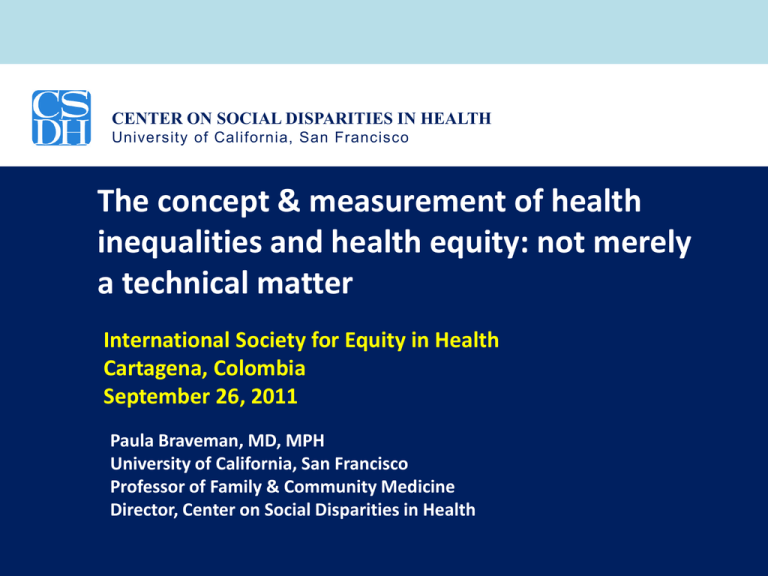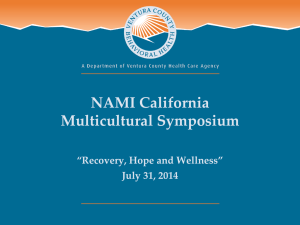
CENTER ON SOCIAL DISPARITIES IN HEALTH
University of California, San Francisco
The concept & measurement of health
inequalities and health equity: not merely
a technical matter
International Society for Equity in Health
Cartagena, Colombia
September 26, 2011
Paula Braveman, MD, MPH
University of California, San Francisco
Professor of Family & Community Medicine
Director, Center on Social Disparities in Health
CENTER ON SOCIAL DISPARITIES IN HEALTH
University of Calif ornia, San Francisco
The concepts & measurement of health
inequalities and health equity– not merely a
technical matter
Does everyone agree?
What is at stake?
An approach based on ethical and human rights
principles
“The poor are getting poorer, but with the rich getting
richer it all averages out in the long run.”
©2000 The New Yorker Collection from cartoonbank.com. All rights reserved
CENTER ON SOCIAL DISPARITIES IN HEALTH
University of Calif ornia, San Francisco
What are “health inequalities”?
Differences, variations: descriptive terms
Most official U.S.A. definitions refer only to
differences between unspecified groups
But we really mean: Health differences that are
unfair (in a particular way)
Whitehead: unfair, avoidable, and unjust
But notions of fairness, avoidability, and justice vary
CENTER ON SOCIAL DISPARITIES IN HEALTH
University of Calif ornia, San Francisco
Are all health differences unfair?
Many women have
obstetric problems;
men do not
Arm/leg fractures
more likely in skiers
than non-skiers
Wealthy people in
Manhattan have some
health problems that
wealthy people in
Hollywood do not
Younger adults are
generally healthier
than the elderly
Some claim that
any avoidable
health difference is
unfair
Who determines
what is avoidable?
CENTER ON SOCIAL DISPARITIES IN HEALTH
University of Calif ornia, San Francisco
What if the causes are not known?
In the USA, compared with European-American
(“White”) newborns, African-American (“Black”)
newborns are 2 to 3 times as likely:
to have low birth weight
to be born prematurely
which predict infant
mortality, childhood
disability and development,
and adult chronic disease
The causes are not known
Can we call it unfair?
CENTER ON SOCIAL DISPARITIES IN HEALTH
University of Calif ornia, San Francisco
Other challenges: Which groups?
The U.S. National Institutes of Health (NIH) has a
new institute on minority health and health
disparities (NIMHD).
Should NIMHD prioritize health of:
Veterans?
People with autism?
People with rare but catastrophic diseases?
Higher incidence of breast cancer among White
women?
Shorter life expectancy among men?
CENTER ON SOCIAL DISPARITIES IN HEALTH
University of Calif ornia, San Francisco
Other challenges: Individuals v. groups
A few researchers (then in leadership roles at WHO)
once proposed that health inequalities should not be
measured by comparing health of pre-selected social
groups, e.g., rich - poor
Because it pre-judges causality, obstructing comprehensive
inquiry into causes
Their approach: compare individuals (not groups) on
health only, then seek explanatory variables
During their tenure, WHO ended an initiative providing
technical assistance to countries to collect & analyze health
data according to markers of social position
Removed fairness & justice from the agenda for health
monitoring
CENTER ON SOCIAL DISPARITIES IN HEALTH
University of Calif ornia, San Francisco
Other challenges: the reference group for a health
equity comparison
Some propose using the average as the reference
group, or the healthiest, regardless of their social
characteristics
Active dispute now in some U.S. public health agencies
What is wrong with using the population average –or
the healthiest-- as the reference group?
Average underestimates inequalities where a higher %
of population are disadvantaged
Many reasons –including biologic--for healthiest group
to be healthiest
CENTER ON SOCIAL DISPARITIES IN HEALTH
University of Calif ornia, San Francisco
Human rights principles provide guidance to
address these challenges
The right to achieve the highest attainable standard
of health
Rights to: education, living standard adequate for
health, benefits of progress
All rights are inter-connected and indivisible
Ratifying human rights agreements obligates
governments to progressively remove obstacles to
realizing all rights
Particularly for groups who have more obstacles
CENTER ON SOCIAL DISPARITIES IN HEALTH
University of Calif ornia, San Francisco
Relevant human rights principles, e.g.:
Non-discrimination and equality
All persons have equal rights and should be able to
realize all their rights without discrimination
Including de facto (unconscious, institutional)
discrimination – not just deliberate, inter-personal
Prohibit policies with either intent or effect of
discrimination
Affirmative action is needed to achieve equal rights
for vulnerable groups
CENTER ON SOCIAL DISPARITIES IN HEALTH
University of Calif ornia, San Francisco
Human rights principles:
Non-discrimination and equality
Specifies vulnerable groups: defined by race or ethnic
group, skin color, religion, language, or nationality;
socioeconomic resources or position; gender, sexual
orientation or gender identity; age; physical, mental, or
emotional disability or illness; geography; political or
other affiliation
Implicit: vulnerability due to history of discrimination or
marginalization, lower social position
A rights-based definition of health inequality
A health difference closely linked with social or economic
disadvantage
Health disparities adversely affect groups of people who
have systematically experienced greater social or economic
obstacles to health based on their
racial or ethnic group; religion;
socioeconomic status; gender;
mental health; cognitive, sensory, or physical disability;
sexual orientation or gender identity;
or other characteristics historically linked
to discrimination or exclusion
A rights-based definition of health inequalities
Not all health differences -- or even
all health differences warranting attention
A particular subset of health differences
that reflect social injustice
Plausibly avoidable, systematic
health differences adversely
affecting a socially
disadvantaged group
May reflect social disadvantage –
but in any case put already disadvantaged
groups at further disadvantage
with respect to their health
CENTER ON SOCIAL DISPARITIES IN HEALTH
University of Calif ornia, San Francisco
Challenges addressed: Burden of proof regarding
causation
The causes of many important health inequalities
(e.g., racial disparities in low birth weight,
premature birth or in stage-specific breast cancer
survival) are unknown
Regardless of causes, health inequalities are unfair
because they put already disadvantaged groups at
further disadvantage on health
Health inequalities are further obstacles to achieving
rights
CENTER ON SOCIAL DISPARITIES IN HEALTH
University of Calif ornia, San Francisco
Challenges addressed: Groups or individuals?
Which groups?
Compare groups with different levels of social
advantage: resources, power, prestige/acceptance
Human rights principles define the groups
Racial/ethnic, religious, or tribal
Socioeconomic (income/wealth, education, occupation)
Gender, gender identity, sexual orientation, age, mental or
physical disability/illness, geographic
Implicit: groups that have historically experienced
discrimination or marginalization
Appropriate groups verifiable based on evidence of
wealth, power (e.g., high political/executive office),
social inclusion (e.g., hate crime victims).
CENTER ON SOCIAL DISPARITIES IN HEALTH
University of Calif ornia, San Francisco
Measurement challenges: The reference group
The most socially privileged group (greatest power,
wealth, prestige) , e.g.,
High income/wealthy individuals, households, or
neighborhoods
Most privileged racial/ethnic group
Indicates what should be possible for all groups (the
“highest attainable standard of health”)
The population average is too low a standard, especially
where large proportions are disadvantaged
The healthiest group may be healthiest for reasons not
reflecting social justice
CENTER ON SOCIAL DISPARITIES IN HEALTH
University of Calif ornia, San Francisco
Contributions of a human rights framework
Addresses de facto discrimination/exclusion
Sets benchmark at highest attainable standard of
health
Entitlement v. charity
Addresses multiple dimensions of material and social
deprivation and disadvantage
Poverty as well as race-based and other discrimination and
their physical and psychosocial consequences
Supports addressing inequalities in social determinants of
health (rights to education, living standard adequate for
health, social participation…)
Reflects global consensus on values and concepts
CENTER ON SOCIAL DISPARITIES IN HEALTH
University of Calif ornia, San Francisco
Concepts and measurement of health inequalities
and health equity: not just a technical issue
Based on values
Equity is the ethical principle underlying
a commitment to reduce inequalities
Health inequalities are the metric by
which health equity is assessed
Human rights principles can guide
analysis, measurement, and action
Implications for policy agendas,
resource allocation, & accountability
Inherently political












